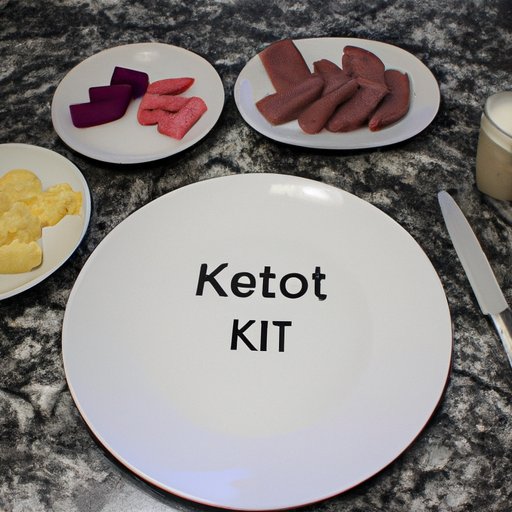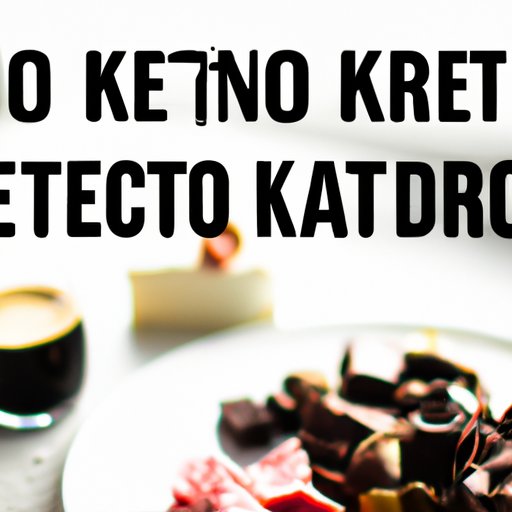Introduction
The keto diet is a popular way to lose weight, but it’s much more than just that. It’s a high-fat, low-carb diet that can help you improve your overall health and wellbeing. By understanding the basics of the keto diet, you can decide if it’s the right choice for you.
What is the Keto Diet?
The ketogenic diet, also known as the “keto diet,” is a high-fat, low-carbohydrate eating plan. It involves drastically reducing carbohydrate intake and replacing it with fat. This reduction in carbs puts your body into a metabolic state called ketosis. When this happens, your body becomes incredibly efficient at burning fat for energy.
The keto diet has been studied extensively over the years. According to one study published in the European Journal of Clinical Nutrition, “The ketogenic diet appears to be a safe, effective, and well-tolerated dietary approach for producing weight loss and improving glycemic control in obese adults.”
Benefits and Risks of the Keto Diet
The keto diet has been linked to various health benefits, such as improved blood sugar control, increased energy levels, and decreased appetite. Additionally, the diet may help reduce risk factors for certain diseases, such as heart disease and type 2 diabetes.
However, the keto diet may not be suitable for everyone. Those with kidney or liver problems should consult their doctor before starting the diet. Additionally, the diet may cause some side effects, such as constipation, headaches, and bad breath.

Getting Started with a Keto Diet
If you’re interested in trying the keto diet, it’s important to understand the basics of the diet before getting started. Here are some helpful tips for starting the keto diet:
Step-by-Step Guide to Starting a Keto Diet
1. Calculate your ideal macronutrient ratios. Macronutrients are the three main types of nutrients: carbohydrates, proteins, and fats. The keto diet typically consists of about 5-10% carbohydrates, 20-25% protein, and 70-80% fat.
2. Stock up on keto-friendly foods. Foods that are high in healthy fats and low in carbohydrates are key to following the keto diet. Examples include avocados, olive oil, nuts, and fatty fish.
3. Track your macros. Tracking your macronutrients will help you stay on track and ensure that you’re following the diet correctly.
4. Be patient. It may take some time for your body to adjust to the new diet. Don’t give up if you don’t see results right away.
Understanding Macros and Macronutrient Ratios
Macronutrients are the three main types of nutrients found in food: carbohydrates, proteins, and fats. Each of these macronutrients plays an important role in your health. On a keto diet, you want to make sure that you’re getting the right amount of each macronutrient.
The ratio of macronutrients you should aim for on a keto diet is typically 5-10% carbohydrates, 20-25% protein, and 70-80% fat. This ratio helps put your body into ketosis, which is when your body starts to burn fat for energy instead of carbohydrates.

Meal Planning Tips for the Keto Diet
When you’re following the keto diet, it’s important to plan your meals carefully. Here are some helpful tips for planning your meals on the keto diet:
Foods to Enjoy on a Keto Diet
When you’re on a keto diet, there are plenty of delicious foods that you can enjoy. Some of the best foods to eat on a keto diet include:
- Eggs
- Avocado
- Nuts and seeds
- Fatty fish (such as salmon)
- Full-fat dairy products (such as yogurt and cheese)
- Leafy green vegetables (such as spinach and kale)
Foods to Avoid on a Keto Diet
It’s important to avoid certain foods when following the keto diet. These foods are usually high in carbohydrates and should be avoided:
- Grains (such as wheat and rice)
- Beans and legumes (such as black beans and lentils)
- Processed foods (such as chips and candy)
- Sugary drinks (such as soda and juice)
- Fruit (except for small portions of berries)
Pros and Cons of a Keto Diet
The keto diet offers numerous potential benefits, but it’s important to understand the potential risks as well. Here’s a look at the pros and cons of the keto diet:
Benefits of the Keto Diet
The keto diet has been linked to several potential health benefits, including:
- Weight loss
- Reduced risk of type 2 diabetes
- Improved cholesterol levels
- Increased energy levels
- Reduced inflammation
Potential Risks of the Keto Diet
While the keto diet may offer several potential benefits, it’s important to understand the potential risks as well. Some potential risks of the keto diet include:
- Nutrient deficiencies
- Digestive issues
- Kidney stones
- Bad breath
- Headaches
Keto Diet Recipes for Beginners
The keto diet doesn’t have to be boring. There are plenty of delicious recipes that you can enjoy while following the diet. Here are some easy recipes to try:
Breakfast Recipes
- Crustless Spinach Quiche
- Avocado Egg Breakfast Bowl
- Keto Pancakes
- Cauliflower Hash Browns
Lunch Recipes
- Keto Chicken Salad
- Low-Carb Burrito Bowl
- Tuna Stuffed Avocado
- Zucchini Noodles with Pesto
Dinner Recipes
- Baked Salmon with Lemon and Dill
- Chicken Parmesan with Zucchini Noodles
- Keto Meatloaf
- Low-Carb Pizza with Cauliflower Crust
Snack Recipes
- Almond Butter and Celery Snack
- Hard-Boiled Eggs
- Cheese and Olives
- Coconut Chips

Common Mistakes to Avoid When Starting the Keto Diet
Starting the keto diet can be challenging, and it’s easy to make mistakes. Here are some common mistakes to avoid when starting the keto diet:
Not Following the Proper Macros
It’s important to follow the proper macronutrient ratios when following the keto diet. As mentioned above, the ideal ratio is 5-10% carbohydrates, 20-25% protein, and 70-80% fat.
Not Eating Enough Fat
When starting the keto diet, many people make the mistake of not eating enough fat. However, it’s important to get enough fat in your diet in order to stay in ketosis. Make sure to include plenty of healthy fats in your meals, such as olive oil, avocados, and nuts.
Eating Too Many Carbs
It’s easy to go overboard on carbs when starting the keto diet. It’s important to stick to the recommended amount of carbohydrates per day in order to stay in ketosis. Aim for 20-50 grams of carbs per day.
Not Staying Hydrated
Staying hydrated is important when following any diet, but it’s especially important when following the keto diet. Make sure to drink plenty of water throughout the day to stay hydrated and to help your body function properly.
Conclusion
The keto diet is a high-fat, low-carbohydrate diet that has been linked to numerous potential health benefits. While the diet may offer several potential benefits, it’s important to understand the potential risks as well. To get the most out of the keto diet, it’s important to understand the basics of the diet and to plan your meals carefully. Additionally, it’s important to avoid common mistakes, such as not following the proper macronutrient ratios and not eating enough fat.
By understanding the basics of the keto diet and following these helpful tips, you can decide if the keto diet is right for you. With the right meal planning and recipes, you can enjoy delicious and nutritious meals while reaping the potential benefits of the keto diet.
(Note: Is this article not meeting your expectations? Do you have knowledge or insights to share? Unlock new opportunities and expand your reach by joining our authors team. Click Registration to join us and share your expertise with our readers.)
